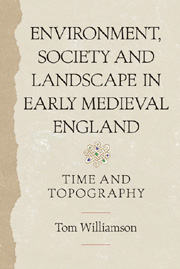Book contents
- Frontmatter
- Contents
- List of Illustrations
- Acknowledgements
- Introduction
- 1 Settlement and Society
- 2 Nature's Frame
- 3 Culture, Ethnicity and Topography
- 4 Small Shires, Deep Roots
- 5 The Gradient of Freedom
- 6 Two Countrysides?
- 7 Village, Farm and Field
- 8 Landscape and Settlement
- 9 Woodland and Pasture
- Conclusion: Time and Topography
- Bibliography
- Index
- ANGLO-SAXON STUDIES
4 - Small Shires, Deep Roots
Published online by Cambridge University Press: 05 April 2013
- Frontmatter
- Contents
- List of Illustrations
- Acknowledgements
- Introduction
- 1 Settlement and Society
- 2 Nature's Frame
- 3 Culture, Ethnicity and Topography
- 4 Small Shires, Deep Roots
- 5 The Gradient of Freedom
- 6 Two Countrysides?
- 7 Village, Farm and Field
- 8 Landscape and Settlement
- 9 Woodland and Pasture
- Conclusion: Time and Topography
- Bibliography
- Index
- ANGLO-SAXON STUDIES
Summary
Regiones and their contexts
In earlier chapters two models for the development of early settlement and territorial organisation in England were introduced and discussed: Glanville Jones's idea of the multiple estate, and the concept of river and wold, formulated by Alan Everitt and elaborated in a variety of ways by Harold Fox and Charles Phythian Adams. Although the two models were largely developed in isolation from each other, and approached early settlement and land use from rather different perspectives, it is clear that there is a measure of congruence between them, both dealing as they do with forms of territorial organisation significantly larger than the townships or parishes of the later Middle Ages. Everitt's model provides a topographic frame for the large territories described by Jones, in the sense that the outlying portions of the latter would generally have coincided with major watersheds, while its core sections, the maenor and main areas of arable land, would have been located within a valley, or valleys. In the ideal model set out in the Welsh law codes the king's court or llys is thus supplied with produce by the mensal lands of the maerdref, located in the arable lowlands. The king's other townships were in the summer pastures of the uplands, suggesting forms of extensive rather than intensive land use, involving a measure of seasonal transhumance. Many researchers, discussing the character of multiple estates and similar archaic territories, have noted their close relationship with the topography.
- Type
- Chapter
- Information
- Environment, Society and Landscape in Early Medieval EnglandTime and Topography, pp. 82 - 106Publisher: Boydell & BrewerPrint publication year: 2012



